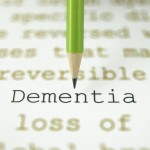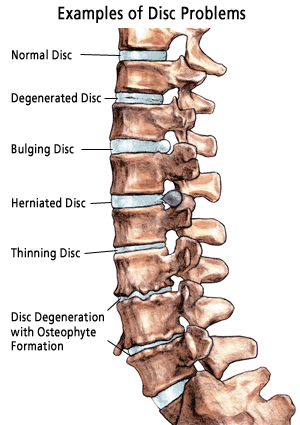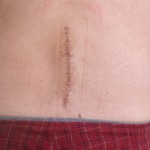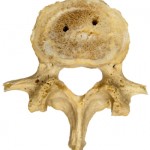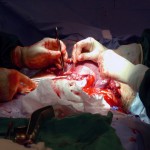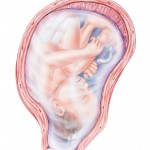In the early and mid 19th century many young mothers died soon after giving birth. They were struck down by childbed fever (AKA puerperal fever), Ever since the time of Hippocrates (460-370 BCE) it had been known that childbirth was a dangerous time for women; there are numerous complications possible around the time of delivery, but childbed fever, in the early and mid 19th century, was investigated and eventually largely prevented by the work of both Oliver Wendell Holmes, known primarily for his brilliance in other fields, and, Ignaz Semmelweis, a Hungarian MD, who these days seems to get most of the credit.
In reality it was Holmes who heard of a physician dying after performing an autopsy on a woman who had died from puerperal fever. He concluded that lack of handwashing was the culprit in transmission of the disease. In 1843 he read a paper on the subject before the Boston Society for Medical Improvement, but its publication, in a medical journal with a small readership, had little effect and a leading Philadelphia obstetrician derided Holmes' work.
Dr. Ignaz Semmelweis finished his MD degree in 1844 and two years later became an assistant to the head of the maternity clinic at the University of Vienna. He noted that two separate birth-centered clinics in the hospital had marked different maternal mortality rates. In the First Clinic medical students were trained and the death rate among new mothers was 10%; in the Second Clinic midwifes were trained and the mortality rate was less than 4%.
Then a colleague died of sepsis after cutting his finger during an autopsy; as in Holmes' index case, it had been on a woman who died of childbed fever. Midwives did not perform autopsies and Semmelweis concluded that he and other physicians were somehow transmitting the disease. He insisted that everyone attending a postmortem examination must scrub their hands.
Although the death rate in the First Clinic feel immediately to match that of the Second Clinic, Semmelweis' concept of infectious particles was ridiculed and a book he published on the subject was ignored.
But eventually handwashing became routine and puerperal fever very rare.
Which bring us up to the modern era and its handwashing dilemma. An article published in The New York Times on May 28, 2013, was titled "With Money at Risk, Hospitals Push Staff to Wash Hands."
More than 160 years after the ground-breaking work of Holmes and Semmelweis, hospital-acquired infections are costing $30 billion and causing nearly 100,000 deaths every year in the United States.
Without some prodding, hospital workers have been shown to wash their hands between patients as infrequently as 30% of the time, unless they receive some form of stimulus to change their behavior. Now Medicare has stepped in and the facilities will loss money when their patents get infections that are preventable.
Why is this a crucial time for our medical staff members to wash frequently?
In the time of Holmes and Semmelweis, there were no antibiotics, so a major infection, once well established could rapidly lead to death. We've got lots of antibiotics now, but a variety of organisms, previously susceptible to drug therapy, are now drug-resistant.
An online discussion of the issue on a Food and Drug Administration (FDA) webpage is titled "Fighting the Impact of Antibiotic-Resistant Bacteria." It mentions several background problems that have contributed to the rising death toll from a number of drug-resistant bugs. Note that their title mentions bacteria. Viruses are not treatable with antibiotics, so if we get the flu or a cold we should never expect our healthcare provider to give us an RX for an antibiotic.
Similarly, the widespread use of these chemicals in the animal industry has certainly contributed to antibiotic resistance. As opposed to treating a sick cow or chicken or pig with meds specific to their condition, utilizing them to improve weight gain in healthy animals is a practice frowned upon by the FDA.
Back to handwashing: some hospitals have hand-washing coaches, give free pizza to those who do follow the routine of washing in and washing out of patient rooms, or even use video snooping to determine who on their staff is guilty of poor technique or skips handwashing entirely.
One hospital on Long island agreed to a test of the video system's results. In a 16-week period where workers were being filmed in the Intensive Care Unit, but weren't given feedback, optimal hand-care practices were recorded in less than 10% of visits to the patient's rooms.
When the same staff members got reports via an electronic billboard and emails, the rate rose to 88%.
At Beth Israel Hospital in Manhattan, doctors, nurses and other staff members who consistently omit their handwashing must take a four-hour remedial infection disease course, and then teach the techniques they've learned to other staff. As opposed to the negative reinforcement of the course, the subsequent teaching sessions were regarded positively.
Patient families are encouraged, in some of these hospital programs, to ask staff entering their loved ones room if they washed according to protocol. The plan was received especially well by parents with sick kids.
A professor in the school of nursing at Columbia University is certainly in favor of the electronic monitoring systems, but notes that some staff members will game the system to the extent of crawling under a waist-high camera or swiping their staff badge and turning on the water, but not actually washing.
If I had such a staff member when I commanded an Air Force medical center, I'd courtmartial them for assault. If I had been in an analogous civilian senior position, I'd fire the person involved, or if he/she were a doc, I'd ban them from the hospital.
So if you visit a patient, be sure to wash in and wash out. And don't hesitate to remind docs, nurses and other staff members if they don't.



